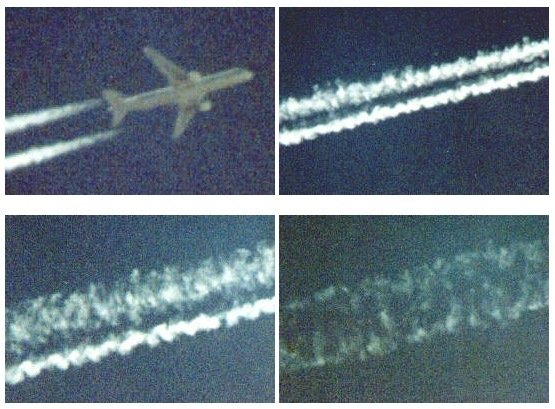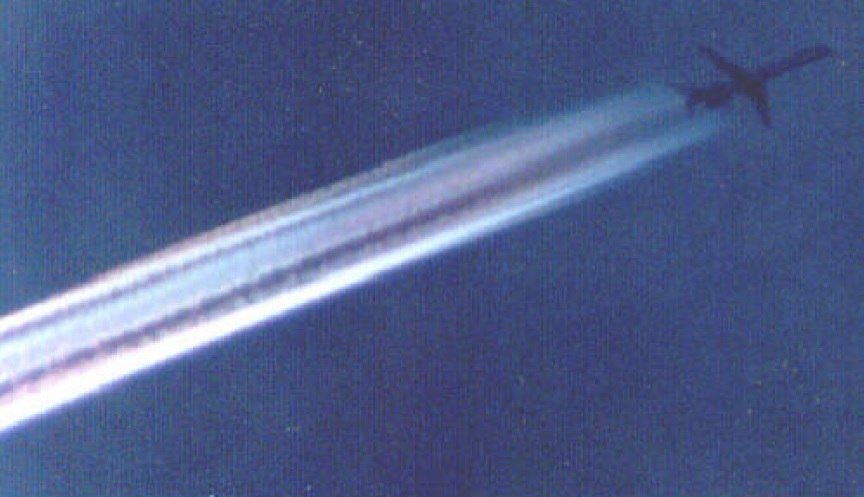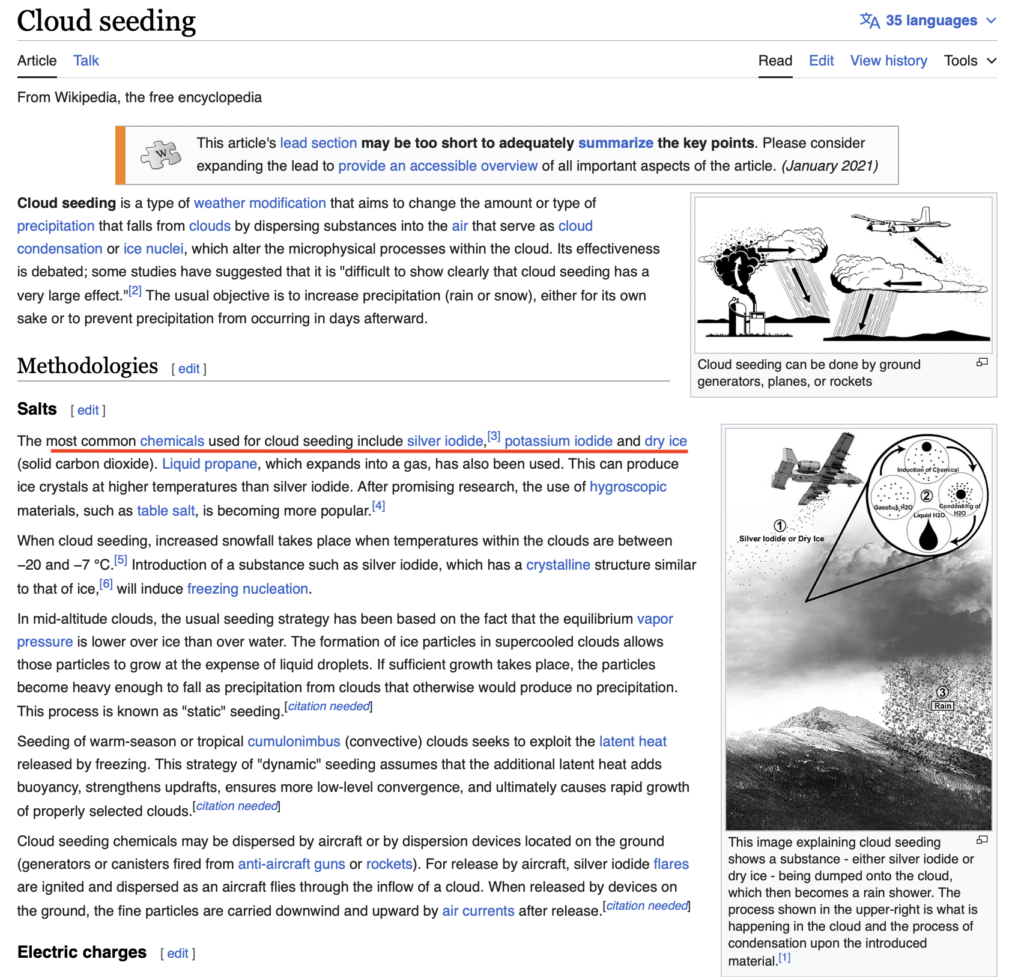Artificial Clouds Are Being Spread Across The Skies of India And The World
Clouds are being manufactured as part of various programs designed by scientists in the field of geoengineering. Geoengineers are interested in managing weather events and controlling the climate of the entire Earth. The actual process of manufacturing artificial clouds is called aerial spraying, aerosol spraying, solar radiation management, or stratospheric aerosol injection. The actual clouds that appear in the sky are called chemtrails or persistent contrails.

The term “persistent contrails” will be used in this article to refer to the cloud formations that have been made by various geoengineering activities.
Persistent contrails contain toxic particles of aluminum, barium, strontium, and many other substances, which are hazardous to human and environmental health. These contrails persist in the sky for many hours. Persistent contrails that are sprayed in the morning will usually remain visible in the early evening. They will start out as thin white lines, and will slowly spread throughout the day to form broad bands and sheets of diffused milky white clouds.

Normal contrails from jet engines are actually rare and primarily contain frozen water vapor. Normal contrails do not persist, but dissipate quickly. They are not considered toxic in comparison to persistent contrails.
Pollution:
- As artificial rain falls, seeding agents like silver iodide, dry ice or salt will also fall. Residual silver discovered in places near cloud-seeding projects is considered toxic. As for dry ice, it can also be a source of greenhouse gas that contributes to global warming, as it is basically carbon dioxide.
The Issue with Cloud Seeding: Negative Impacts on the Environment

What is Cloud Seeding?

Types of Instruments Used for Cloud Seeding:

Related Article:
Why are Persistent Contrails being Created?
Some people believe that the creation of persistent contrails is part of a secret strategy to reduce global warming. Others believe that the spraying has to do with preventing rain, causing rain, or modifying weather patterns. Some believe it is part of a military system for encapsulating and distributing biological and chemical agents over large population areas. Still other researchers believe that the spraying program is part of various military computer systems designed to hide aircraft, create 3D images of ground terrain, and for developing weapon systems that utilize charged particles and atmospheric plasma in connection with the military’s High-frequency Active Auroral Research Project (HAARP).
Karnataka Government Launched Clouding Seeding Project Varshadhari 2017

Karnataka Government has launched clouding seeding Project Varshadhari in Bengaluru under which an aircraft will spray chemicals to induce rainfall. The cloud seeding project is an experimental project that will cover the Bengaluru, Gadag, and Yadgir districts of the state.
Cloud seeding Project Varshadhari in Bengaluru to deal with poor monsoons in the state. Under the project, an aircraft will spray chemicals to induce rainfall.
The purpose of the project is to condense small water particles by clouds (size less than 10 microns) to droplets of 50 microns, which can constitute rains. It is an experimental project that will cover the Bengaluru, Gadag, and Yadgir districts of the state. Cloud seeding (also known as the weather modification technique) is an artificial way to induce moisture in the clouds so as to cause rainfall.
Some people have doubted flood due to weather modification done by the Karnataka government:
- 2018 Karnataka Flood: The year 2018 witnessed another catastrophic flood in Karnataka. Heavy rainfall and overflowing rivers caused extensive damage to residential areas, agricultural lands, and transportation networks. Many districts were submerged, leaving thousands displaced and in distress.
- 2019 Karnataka Flood: The monsoon season of 2019 unleashed another wave of destruction, with floods wreaking havoc across the state. Overflowing rivers, landslides, and collapsed bridges disrupted the lives of countless people, resulting in significant losses.
- Karnataka Flood 2022: Corruption responsible for floods in the state?
Related Article:
List of Cons of Cloud Seeding
1. It uses potentially harmful chemicals.
It is important to know that cloud seeding does involve the use of chemicals in the air, which means that it can potentially harm the environment, especially plants and animals. However, the complete effect of cloud seeding on the environment as a whole is not fully known yet. Though silver iodine is slightly known to be harmful to our health today, but it might change in the future as more research is done and completed.
2. It is not really proven to be effective.
After some evaluation of its effectiveness, cloud seeding is found not to be foolproof as of the moment. The technique is mostly used on clouds that already show early signs of rainfall, so it is not known if it is actually the cause of rain. Plus, the high cost of doing it is not even believed to be justifying its effectiveness.
3. It may affect the weather in a negative way.
Though it is believed to regulate the weather, cloud seeding is feared to ultimately change climatic patterns that exist on Earth. This means that places that would normally receive moisture may start to experience drought due to the artificial process of adding compounds to the atmosphere to trigger rainfall.
4. It can pose a negative risk for living organisms.
Since the cloud seeding process requires the placement of chemicals into the air, it would obviously have undesirable concerns for plants and animals below. How the chemicals are used in this technology will affect the organisms that will be hit by its artificial rainfall, which is considered its most direct concern.
Plus, the use of silver iodine slightly recognized whether it can lead to any severe negative effects or not on the health of plants and animals, but a lot of organizations have been continuously doing extensive research about its long-term effects.
5. It requires huge amounts of investments.
Aside from the health of plants and animals, the cost of cloud seeding is another big concern, as it could be really costly to deliver chemicals to the sky and have them released into the air.
6. It can lead to flooding and undesirable weather problems.
Once the silver iodine and other chemicals are released into the atmosphere, there is no controlling of what type of weather would form. It is likely that there will be too much rain, which can cause the problem of flooding. This would be very difficult for regions experiencing chronic water shortage, as they probably have no system in place to deal with damage to be caused by flooding. Hail is another risk that can cause a great deal of damage to property in urban areas in a short period of time. In rural communities, hail can flatten crops, causing probable food shortages. Some people even fear that, rather than solving water-shortage problems, cloud seeding would just make them worse.
Additional Information:
8 Chemicals Used in Artificial Rain – Cloud Seeding
“As technology is advanced, now people can create artificial rain by adding some chemicals to seed the cloud. What are those chemicals? Here is the list of chemicals used in artificial rain.”
- Silver Iodide
The main compound of cloud seeding for artificial rain is silver iodide. Silver iodides are examples of inorganic compounds with chemical formula Agl. Silver iodide is a highly photosensitive as a reaction of iodide solution with silver ions. The chemical has yellowish color and the solid form of it can precipitate quickly. Silver iodide acts as trigger or hook for the seeded cloud to precipitate. The chemical blends with the cloud and induce the freezing cloud to release it in the form of water. With such function, silver iodide is a chemical used in artificial rain.
- Potassium Iodide
Another chemical needed in cloud seeding to create artificial rain is potassium iodide. Potassium iodide is similar to silver iodide except for the fact that potassium iodide is not only for artificial rain but also for other uses. People used potassium iodide as a shield against nuclear radiation in Chernobyl incident. It is also effective to protect some of human’s internal organ. In cloud seeding, potassium iodide functions as photosensitizer in the application of photochemistry in modern life with silver nitrate. It is also the chemical that forms silver iodide with nitrate as combination. Because of its function, it is used to make artificial rain as well.
- Carbon Dioxide
Carbon dioxide in the form of dry ice is also important in the making of artificial rain. This chemical is a colorless gas with chemical compound CO2. While carbon monoxide is carbon atom that bonds only with one oxygen atom, carbon dioxide bonds with two atoms and is not as dangerous as monoxide one. When it is in the form of ice, carbon dioxide will help to weigh down the clouds and press the trapped water to fall down to surface of the earth. Dry ice is not similar to ordinary ice so it functions purely as additional weight to the cloud and does not contain water. (Related to: Chemicals in Water supply).
- Propane
Propane is an alkane compound with three carbon atoms. It has the chemical formula of C3H8. Propane is a common substance used as fuel is a natural gas that often is colorless but under certain circumstance can turn into liquid form. Propane gas as cloud seeding material acts as a pusher to encourage the clouds to precipitate. The liquid form of it will also trigger the clouds to release a liquid form of itself, further cause rain. Propane needs other chemical to be able to properly run its function in cloud seeding. Regardless, propane is important in the process of artificial rain.
- Calcium Carbide
During agitation state calcium carbide is used in the making of artificial rain. Calcium carbide along with calcium oxide acts as absorbers of water vapour. It consists of salt and urea or ammonium nitrate. This chemical is a calcium compound with formula CAC2. It is usually colorless but can also appear white-ish. To produce calcium carbide, lime and coke mixture in an electric arc furnace reaction will result in calcium carbide. Furthermore, the role in artificial rain is to trigger precipitation in the sky clouds.
- Ammonium Nitrate
Another chemical involved in cloud seeding is ammonium nitrate. Ammonium nitrate is the nitrate salt of ammonium cation with chemical formula NH4NO3. Appear in crystal white solid form, ammonium nitrate commonly used as fertilizer in agriculture. However, this chemical also plays role in the cloud seeding process to create artificial rain. Along with other chemicals, ammonium nitrate acts as the one that increase nuclei and to increase the density of the clouds as well. Nuclei is beads of water contained in the clouds that should fall as rain. With such function, ammonium nitrate is among the chemicals used in artificial rain.
- Sodium Chloride
Alternative chemical beside silver iodide to create artificial rain is sodium chloride. Sodium chloride is a chemical compound with formula NaCl. The formation of sodium chloride is one portion of sodium and one portion of chloride. Commonly known as salt, it is an ionic compound that can also acts as denser in artificial rain making. The chemical will make the cloud dense with big beads of water, further pushing them to create precipitation and drop rain onto the earth’s surface. The use of it is considered to be more expensive compared to silver iodide and is only used occasionally during extreme dry season.
- Urea Compound
Another chemical that usually utilized in agriculture but is also able to help in cloud seeding is urea. Urea compound is also known as carbamide with chemical formula CH4N2O. The chemical comes with white solid appearance that is often used as plants fertilizer. In cloud seeding, urea acts as the one that absorb the water vapour. As a result, it will create a more dense cloud to break down the super cool clouds. Moreover, it also stimulates the formation of water mass from crystallized water in the clouds. Thus, urea is also chemical used in artificial rain.
Artificial rain is now a common one resulted from cloud seeding to trigger rain in places that have not received any rains in a long period of time. Although there is a discussion about the harm of chemicals used in artificial rain, this method is effective enough and is trusted by many countries to save the climate. Indeed, there are 8 list of chemical used in artificial rain you should know.”
Disadvantages
> For cloud seeding to be successful, suitable meteorological conditions are required. Cloud seeding requires the presence of moisture-filled clouds, which are not always available or predictable.
> It is not fool-proof. Artificial rains cannot be considered as a guaranteed solution. An IIT Kanpur professor explained that it was alike natural rains and helps in settling down suspended dust and particulate matters present in the environment. He suggested action should be instead taken on the actual sources of pollution.
> Effectiveness of cloud seeding differs from project to project
> Use of potentially harmful chemicals can affect plants. The paper says there is no substantial study done on the implications of silver iodine on the environment ( why still ignorant about conducting a study?) However, “Silver iodine may cause ― iodism, a type of iodine poisoning where the patient exhibits running nose, headache, skin rash, anemia, and diarrhea, among others,” it added.
> According to several reports, artificial rains might eventually change climatic patterns. “If not regulated or controlled properly, cloud seeding may cause undesirable, if not altogether, destructive weather conditions such as flooding, storms, hail risks, etc,” the paper said.
Explaining further, it said that places that naturally receive less rainfall or no rain at all, “usually do not have the infrastructure to handle so much precipitation”. Therefore, with cloud seeding, these areas may become flooded quickly, “causing more harm than good”, it added.
> The process to generate artificial rains is very expensive
However, the risks or concerns of cloud seeding “may just not be bad enough”.
A research by Alan Robock, from the Department of Environmental Sciences, Rutgers University, New Brunswick, New Jersey, USA, discussed the benefits and risks of cloud seeding.
In the summary, he said, “…Risks or concerns like unwanted ecological changes, ozone depletion, continued ocean acidification, erratic changes in rainfall patterns, rapid warming if seeding were to be stopped abruptly, airplane effects, to name a few, may just not be bad enough to override the imperative to keep temperatures down.
Artificial rains cannot be considered as a guaranteed solution. An IIT Kanpur professor explained that it was alike natural rains and helps in settling down suspended dust and particulate matters present in the environment. He suggested action should be instead taken on the actual sources of pollution.
Ref: https://www.livemint.com/news/india/delhi-air-pollution-benefits-disadvantages-cost-of-artificial-rains-all-you-need-to-know-11699886905784.html
Final Note: Can Artificial Rain Benefit Delhi or Result in Environmental Consequences?
Source: Health Impact News, Connectus, Edristi, zerogeoengineering, YouTube, Twitter
